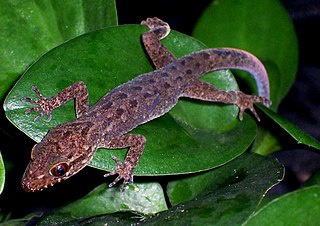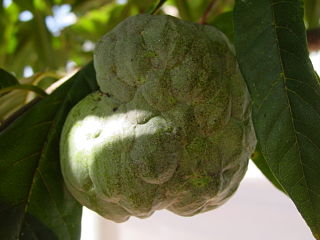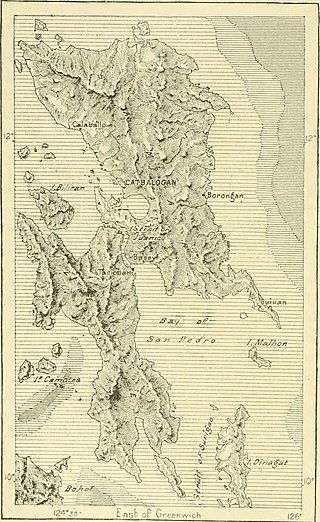
Cyrtodactylus is a diverse genus of Asian geckos, commonly known as bent-toed geckos, bow-fingered geckos, and forest geckos. The genus has 361 described species as of 2024, which makes it the largest of all gecko genera.

The Annonaceae are a family of flowering plants consisting of trees, shrubs, or rarely lianas commonly known as the custard apple family or soursop family. With 108 accepted genera and about 2400 known species, it is the largest family in the Magnoliales. Several genera produce edible fruit, most notably Annona, Anonidium, Asimina, Rollinia, and Uvaria. Its type genus is Annona. The family is concentrated in the tropics, with few species found in temperate regions. About 900 species are Neotropical, 450 are Afrotropical, and the remaining are Indomalayan.

Physignathus cocincinus is a species of agamid lizard native to southern China and mainland Southeast Asia. It is commonly known as the Chinese water dragon, Indochinese water dragon, Asian water dragon, Thai water dragon, or green water dragon.
Nanohyla nanapollexa is a species of frog in the family Microhylidae. It is also known as the no-thumb pigmy frog and three-fingered pigmy narrow-mouth frog. It is endemic to Vietnam and is known from Quang Nam and Phu Yen Provinces.

Polyalthia is a genus of flowering plants in the family Annonaceae. There are approximately 90 species distributed from Africa to Asia and the Pacific.

Huberantha nitidissima, commonly known as canary beech or shiny leaf tree, is a plant in the custard apple family Annonaceae. It is found in seasonal tropical forests and along moist watercourses in New Caledonia, Vanuatu and the Australian states of New South Wales, Queensland, and the Northern Territory.
Panax vietnamensis or Vietnamese ginseng is a species of the ginseng genus Panax. In Vietnam the species, prized in herbal medicine, is commercially very valuable and now considered threatened.

Meiogyne is a genus of flowering plants with 38 species belonging to the family Annonaceae. It is native from southwestern India and Indochina to Australia, including Fiji and New Caledonia. The type species is Meiogyne virgata.

Huberantha cerasoides is a species of trees in the family Annonaceae and tribe Miliuseae. It is the type species of the relatively new genus Huberantha.

Huberantha is a genus of plants in the family Annonaceae and tribe Miliuseae. It is distributed in Australia, tropical Asia, East Africa and some Pacific islands. Tanawat Chaowasku named the genus "Huber's flowers" in honor of the German botanist Herbert Huber and to highlight its flowers as a distinguishing feature of the genus. A number of species have been moved here from the genus Polyalthia.
Pinanga sylvestris is a species of tree in the Arecaceae, or palm tree, family. It grows 2-6 m tall, sometimes in bundles, shade tolerant, from Meghalaya (India) to Thailand, Cambodia, Vietnam, Laos and Zhōngguó/China. In Thailand it is recorded in the Khao Soi Dao Wildlife Sanctuary, in Chanthaburi Province, as a very common mid-storey tree in the Quercus semiserrata-dominated rainforest at 1,400 to 1,540 m. In Cambodia it occurs uncommonly in coastal vegetation communities, but is common in dense and semi-dense evergreen rainforest in the lowlands and at moderate altitude. The palm grows in similar dense and semi-dense communities in Laos and Vietnam. On the mountain of Ngọc Linh in Quảng Nam Province of Vietnam, it dominates the ground layer of low montane broadleaf evergreen forest, that occurs from 150 to 1000m.
Wuodendron is a genus of plants in the family Annonaceae and tribe Miliuseae, containing the type and only species Wuodendron praecox. It is distributed from northeastern India north to southern China and southeast through most of Mainland Southeast Asia.

The Malmeoideae are a subfamily of trees and other plants of the family Annonaceae.

Annonoideae is a subfamily of plants in the family Annonaceae, with genera distributed in tropical areas world-wide. The family and this subfamily are based on the type genus Annona.

The Northern Vietnam lowland rain forests ecoregion covers the central-eastern coast of Vietnam from the Red River delta in the north to Tam Kỳ in the center of the country and neighboring adjacent parts of Laos. The region is one of the wet evergreen forests, with rain over 50 mm in every month. The forests have been highly degraded by human use, and the high levels of biodiversity have been pushed back into relatively small protected areas like Pu Mat National Park.
Polyalthiopsis is a genus of plants in the family Annonaceae and tribe Miliuseae. Its native range is Tibet, China and Vietnam.

Uvaria dulcis is a species of woody climber in the Annonaceae family. It is found in tropical Asia, in a disjunctive distribution, eastern Indonesia, Jawa, and then Mainland Southeast Asia. The plant has an edible fruit, which in Khmer language has the colourful name triël dâhs krabéi.

Memecylon plebejum is a tree or shrub species in the Melastomataceae family. It grows in tropical Asia from Thailand to Myanmar, Assam (India) and Bangladesh. It favours slopes of hills and mountains, growing up to 1685m elevation, in the understorey of primary forests primarily. It hosts at least one fruit-fly and two parasitoid wasps. The wood is very hard to cut, making it difficult to use as firewood, but some people use it for agricultural tool handles.
Dendrokingstonia is a genus of flowering plants belonging to the family Annonaceae.
Pseuduvaria fragrans is a species of plant in the family Annonaceae. It is native to Thailand. Yvonne Su, Tanawat Chaowasku and Richard Saunders the botanists who first formally described the species, named it after its strongly fragrant flowers.











